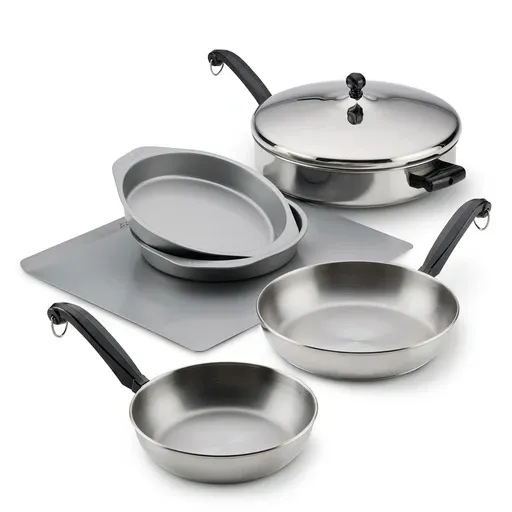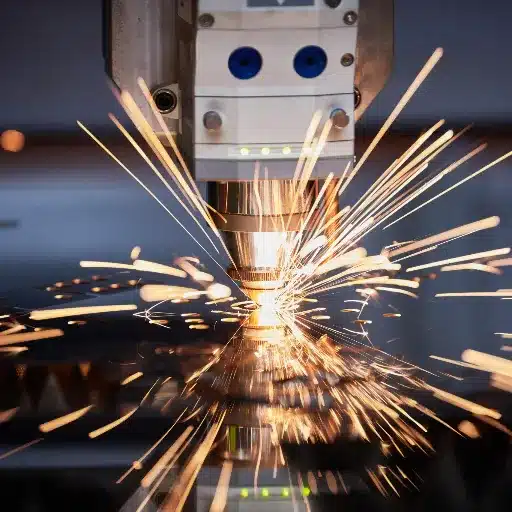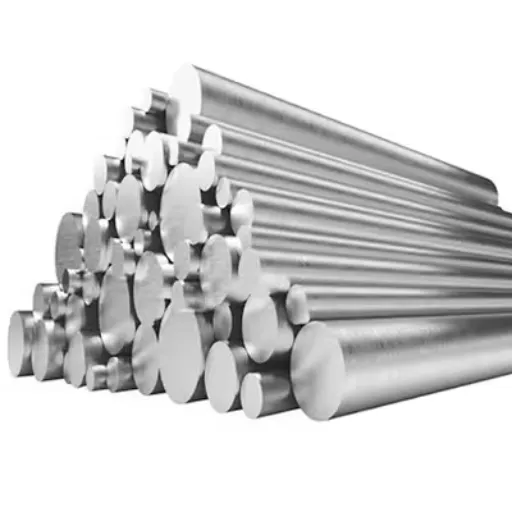Durability, versatility, and timeless appeal describe the many desirable properties of stainless steel when it comes to cookware. If you are a professional chef or a home cook, stainless steel cookware is a worthy investment that can make all the difference in kitchen utility. But with all the choices in the market, what does one look for? This guide takes you through all aspects of stainless steel cookware, including its unique features and tips on selecting the right pieces to satisfy your needs. By the end, you will have learned enough to ensure more than one instance of good meals and easy cooking.
Understanding 18/0 Stainless Steel
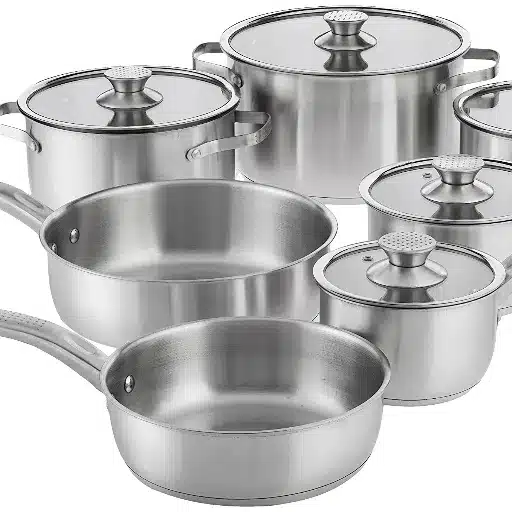
What is 18/0 Stainless Steel?
18/0 stainless steel is basically an alloy of stainless steel consisting of 18% chromium and 0% nickel. It belongs to a family of ferritic stainless steel, best known for their corrosion resistance and magnetic properties. The absence of nickel makes the 18/0 steel much cheaper than either 18/10 or 18/8, which have a relatively heavy concentration of nickel.
The 18% chromium content can allow 18/0 stainless steel to resist rust and staining fairly well; hence, it is somewhat preferred for flatware, kitchen utensils, and some types of cookware. However, being nickel-free, it becomes less resistant to increased corrosion and something less durable compared to other grades of stainless steel. This is a useful attribute in times when the person buying it is allergic to nickel, or more budget-conscious in-bearing soccer.
Key Properties of 18/0 Stainless Steel
🛡️ Resistance to Corrosion
The content of chromium in 18/0 stainless steel permits it to have moderate resistance against corrosion. It does not resist rust as good as higher grades of stainless steel such as 18/8 or 18/10 do. It rather does well in situations involving low moisture and minimal exposure to acids and salt.
🧲 Magnetic Properties
Without the presence of nickel, 18/0 stainless steel behaves as a magnetic material and so is suitable for induction cooking. This makes the use of this steel grade convenient and versatile in modern kitchens employing induction technology.
💰 Cost-Effective
Its lack of nickel content not only affects its characteristics but also greatly decreases the production cost, thus making 18/0 stainless steel a budget-friendly option for consumers looking for something reusable and cheap enough for kitchenware.
Benefits of Using 18/0 Stainless Steel Cookware
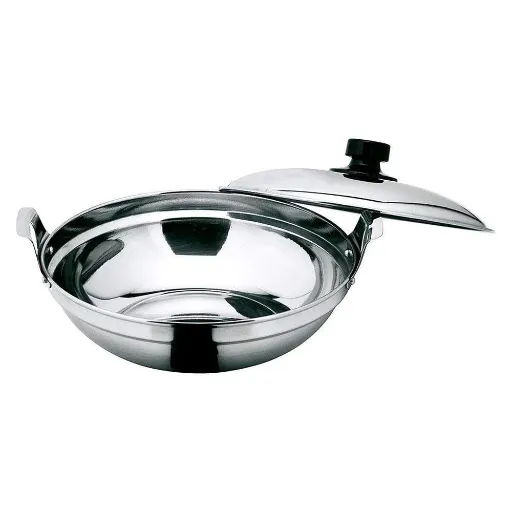
I find 18/0 stainless steel cookware a very good choice for affordability, durability, and compatibility with induction cooktops. It does not bear nickel, so cost-wise, it stands out, but it provides the necessary durability and functionality in the kitchen.
🌿 Non-Toxic Cooking
The primary good thing about the 18/0 stainless steel cookware is that it is non-toxic. The non-stick cookware usually contains chemicals like polytetrafluoroethylene (PTFE) or perfluorooctanoic acid (PFOA), which break down under high heat and sometimes release harmful or potentially harmful substances. 18/0 stainless steel is an alternative, safer option since it is nickel-free stainless steel. Therefore, this type of stainless steel is excellent for people allergic to nickel, thus protecting them from concerns when cooking.
On the other hand, 18/0 stainless steel cookware is highly resistant to leaching, even when in contact with acidic food, such as tomatoes or citric fruits. According to recent studies, low nickel stainless steel cookware, such as 18/0, practically do not pose a threat in releasing any harmful toxins and are, therefore, a perfect choice for anyone concerned about their health. Such durability and chemical resistance will ensure that the preparation is done in a clean and safe environment without compromising on the quality or taste of the food.
⏰ Longevity
18/0 stainless steel cookware is known for durability, making it a serious consideration as a long-time investment for the kitchen, both private and commercial. In being 18% chromium and 0% nickel, the material provides good resistance to rust and corrosion under normal usage conditions. Chromium forms a passive oxide layer on the surface, which acts as a protective barrier against environmental influences like moisture and oxygen.
Recent manufacturing developments, such as cold rolling and precision forging, have greatly increased the tensile strength of 18/0 stainless steel. It is a fact that well-made 18/0 stainless steel cookware, if used regularly, can keep its structure intact for over ten years, significantly longer than any aluminum or coated non-stick surface.
Comparison with Other Stainless Steel Grades

In viewing 18/0 stainless steel against other stainless steel grades, I pinpoint its distinguishing factors: Unlike 18/10 or 18/8, which contain nickel for corrosion resistance, 18/0 does not have this element and therefore is cheaper and suitably applicable in nickel allergen-sensitive applications. Though it may not exhibit as much corrosion resistance as the higher grades, its resistance to heat and cheapness in comparison make it preferable for many cooking and kitchen applications.
| Grade | Composition | Key Features | Best For |
|---|---|---|---|
| 18/10 | 18% chromium, 10% nickel | Superior corrosion resistance, fine finish, excellent durability | High-end cookware, commercial kitchens |
| 18/8 | 18% chromium, 8% nickel | Good corrosion resistance, reasonable price-quality balance | Average household cookware |
| 18/0 | 18% chromium, 0% nickel | Magnetic, affordable, nickel-free | Budget-conscious buyers, induction cooking, nickel-sensitive individuals |
Nickel-Free vs. Nickel-Containing Cookware
In comparing nickel-provided and nickel-free cookwares, one has to consider the material composition, durability, health factors, and performance. Nickel-containing stainless steels, such as 18/10 or 18/8 grades, are well-known for their ability to resist corrosion and maintain a good polished finish for years. The addition of nickel makes the rust resistance better, thus making these grades popular among high-quality cookware. On the flip side, nickel-free stainless steel, usually comprised of the 18/0 or comparable grades, would accentuate affordability options while sacrificing a bit on resistivity toward corrosion.
Healthwise, nickel-free cookware is generally preferred by nickel-allergic or sensitive individuals; this reduces the chance of nickel leaching into the food. What is brought out by studies and consumer feedback is that the chance of nickel exposure from the use of stainless steel cookware is quite low, but the prolonged use of cooking with acid foods in nickel-containing cookware may lead to trace amounts from release. According to a study in 2020, higher nickel content cookware showed extremely little leaching during regular cooking conditions; such a risk does, however, remain for nickel-sensitive individuals.
Top 18/0 Stainless Steel Cookware Recommendations

If protecting against exposure to nickel is of utmost importance for you, then I suggest buying an 18/0 stainless steel cookware. This grade contains no nickel whatsoever; thus, it guarantees less nickel leaching, especially when cooking acidic foods. Although 18/0 types of stainless steel might be more prone to corrosion than their higher-nickel counterparts, it is definitely a better choice for anyone with a nickel allergy.
🏆 Top Brands in 18/0 Stainless Steel Cookware
1. Calphalon
Calphalon is an extremely renowned maker of stainless steel cookware, which includes the finer offerings in 18/0 stainless steel. Their products are prized for their even heating and non-reactive surface, which makes them ideal to cook any acidic or high-temperature preparations. In effect, Calphalon’s 18/0 lines are generally considered quite reasonably priced given the excellent level of performance.
Rating: ⭐⭐⭐⭐⭐ 4.5/5 stars (1,500+ reviews)
2. Cuisinart
The Cuisinart brand produces multiple lines of cookware in 18/0 stainless steel. The name is well reputed for smooth finishes and practical functions, earning the brand a household favorite among both home cooks and professionals. The best 18/0 stainless steel cookware set is Cuisinart Chef’s Classic Stainless Cookware Set, which offers maximum durability and ease in cleaning.
Rating: ⭐⭐⭐⭐⭐ 4.6/5 stars (Amazon)
3. Farberware
Farberware is a tried-and-true name that provides economical cookware options. Their 18/0 stainless steel pieces have excellent heat conduction properties and promise durability over time. Farberware Millennium Stainless Steel 10-Piece Set is maybe the most common example of combining price advantage with efficient performance.
Rating: ⭐⭐⭐⭐ 4.3/5 stars (2,000+ reviews)
Maintenance and Care Tips for Longevity
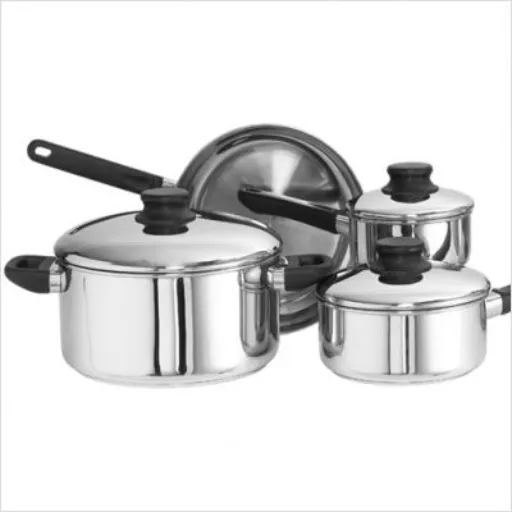
Unless one’s cookware is a lifetime piece, it will need frequent cleaning. Washing with a mild detergent and hand-washing are recommended, while the use of abrasive pankist sponges should be avoided. Always cool-for-cleaning; the high heat of an uncooled pot should never batter-your-coating. Baking soda mixed with water is an excellent remedy when stains do come down to brave them.
🧼 Cleaning and Dishwasher Safety
Maintenance facilitates functionality and makes cookware last longer. Cleaning methods depend on the material of the cookware, or choosing the wrong method may damage the cookware and hamper its performance.
For nonstick pans, hand-wash with warm water, mild soap, and a soft sponge. This coating is very sensitive to abrasive materials and strong cleaning agents which otherwise would ever scratch and degrade the surface of such pans. In a recent survey, Good Housekeeping notes that 64.9% of nonstick cookware owners agree that the life of a pan improves with not using the dishwasher to clean them.
✨ Preventing Discoloration and Stains
Discoloration and staining of cookware are ordinary problems that can result from several causes: exposure to high heat, chemical reaction, and accumulation of food residues. Since one is about to mitigate these causes, it is essential to adopt preventive mechanisms according to the material of the cookware being targeted.
- For Stainless Steel: Stainless steel cookware can discolour from heat through oxidation. To restore shine to discoloured areas, baking soda paste made from it and water is gently rubbed over the affected areas and then rinsed thoroughly.
- For Nonstick Surfaces: Big no to abrasives and harsh cleaners thereon, for doing so only endangers the surface against staining.
- For Hard Water Stains: Hard water stains due to calcium build-up can be removed by boiling a water-vinegar solution inside the cookware for about 10-15 minutes.
Reference Sources
-
Caraway Home Blog
- Title: 18/0 vs. 18/8 vs. 18/10 Stainless Steel: What’s the Difference?
- Summary: This blog explains the differences between various grades of stainless steel, including 18/0, and highlights its affordability and suitability for budget-conscious consumers.
-
Xometry Resources
- Title: Comparing 18/8, 18/10, and 18/0 Stainless Steels
- Summary: This resource compares the properties of different stainless steel grades, focusing on their corrosion resistance, durability, and applications, including cookware.
-
Reddit – AskCulinary Community
- Title: Regarding pots/pans that are all stainless steel, what is the …
- Summary: A community discussion where users share insights and experiences with stainless steel cookware, including 18/0 grade, providing practical perspectives.
❓ Frequently Asked Questions (FAQs)
What is 18/0 stainless steel cookware and how does it differentiate compared to other stainless steel ones?
18/0 stainless steel cookware is made from a specific stainless steel grade containing 18% chromium and zero percent nickel. This type of stainless steel is generally preferred for its nickel-free properties, considered safe for those with nickel allergies. Hence, 18/0 stainless steel cookware fares cheaper than 18/8 or 18/10 stainless steel, and has better resistance against rust and corrosion.
What are some of the great benefits of using stainless steel pots and pans?
Stainless steel pots and pans are durable, non-toxic, and very easy to clean. When cooking, they offer excellent heat distribution and resist scratches and dents. They can be used with a variety of cooking methods, including induction, and are often dishwasher-safe, making cleaning a breeze.
Are there any health concerns related to stainless steel cookware?
High-quality stainless steel cookware, such as that made with 18/0 stainless steel, is relatively safe from health issues. It is non-toxic, contains no harmful chemicals such as PFAS, PFOA, or PTFE, and is safe for cooking many types of foods, including soups and sauces.
How do I find the best set of stainless steel cookware?
A few things to consider when shopping for a stainless steel cookware set are the types of stainless steel used, the thickness of the piece, and either if it is clad or tri-ply. A good set should include at least a saucepan with lid, a stockpot with lid, and a selection of pots and pans based on your cooking needs.
Is 18/0 stainless steel cookware usable on electric and induction cooktops?
18/0 stainless steel cookware is still a recommended option for electric induction cooktops. Its sturdy construction allows for good heat distribution, a must for uniform cooking. Consider the base of your cookware in relation to induction cooktops for it to work best.
What is the maintenance process of stainless steel cookware?
Stainless steel cookware should be cleaned with warm soapy water after each use; harsh treatments or abrasive cleaners may scratch its surface. Baking soda and water can help to remove persistent dirt, while drying thoroughly after cleaning prevents water spots from forming.
🍳 Ready to Upgrade Your Kitchen?
Whether you’re looking for budget-friendly options or professional-grade performance, 18/0 stainless steel cookware offers the perfect balance of affordability, durability, and health-conscious cooking. Make the smart choice for your kitchen today!

